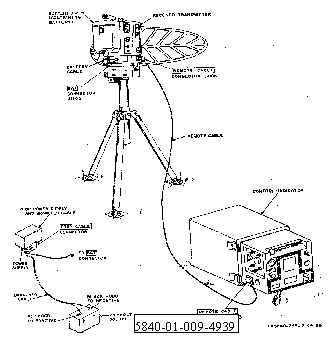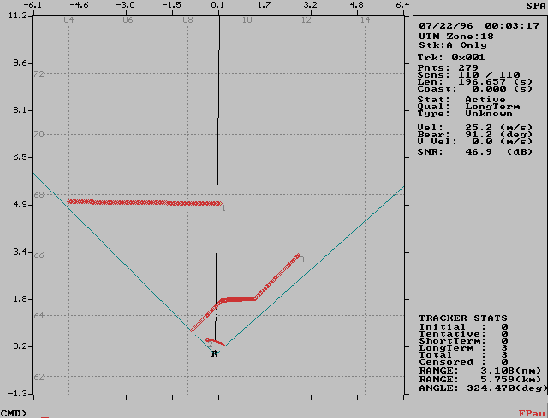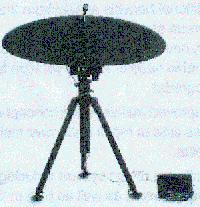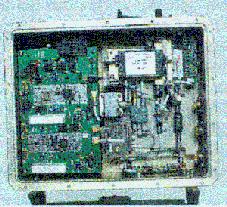The AN/PPS-5B Ground Surveillance Radar Set is a lightweight, man-portable, ground-to-ground surveillance radar set for use by units such as infantry and tank battalions. The radar is capable of detecting and locating moving personnel at ranges of 6km and vehicles at ranges of 10km, day or night under virtually all weather conditions. The radar has a maximum display range of 10,000 meters and targets can be displayed both aurally and visually. Built for durability, the AN/PPS-5B Radar is rugged enough to withstand rough field handling. When packed in its watertight container, it can be parachute dropped and undergo repeated submersion. Increased operational flexibility is afforded when the unit is mounted in a jeep. The system includes everything necessary for operation including 24 VDE external power converter, carrying harnesses, tripod, an adapter for vehicle mounting, four (4) rechargeable batteries (BB-622) and a fifty (50) foot cable for remote operations.
NOTE: The CECOM Supply and Maintenance Bulletin Vol 20, no. 2 Summer 94 provides information for swapping unserviceable AN/PPS-5(A,B) Radars for serviceable ones. Repair is the only source of supply. As soon as one is down, order one through swap out. In order to swap out a radar, the serial number and turn-in document number must be furnished to the Item Manager, Ms. C. Brown DSN 992-5781/2.
TRANSPORTATION CHARACTERISTICS / LIMITATIONS:
HISTORICAL BACKGROUND:
Mar 75 Sole Source to Eaton Corp. - AN/PPS-5A Radar.
May 78 Sole Source to Eaton Corp. - AN/PPS-5B Radar FMS Customer.
Sep 78 Sole Source to Eaton Corp. - AN/PPS-5B Radar.
Oct 89 Sole Source to Telephonics Corp. - AN/PPS-5B Radar FMS Customer.
Apr 94 US Government agreed to accept units built with no-cost warranty against EMI Failures.
Jul 94 Portugal accepted warranty and contract was modified P00053.
REQUIREMENTS DOCUMENT:
TYPE CLASSIFICATION: Type classified Standard "A" on 3 Jun 78.
|
EVENT SCHEDULE FISCAL YEAR |
96 |
97 |
98 |
99 |
00 |
01 |
|
QTR |
1 2 3 4 |
1 2 3 4 |
1 2 3 4 |
1 2 3 4 |
1 2 3 4 |
1 2 3 4 |
|
Repair of 50 Radars |
------4--- |
------4--- |
------4--- |
------4--- |
------4--- |
------4-- |
 The AN/PPS-5 Ground Surveillance Radar is a thirty-five (35) year old system. Since the late 1980's, soldiers have been complaining about the need for a new radar system. The system has been around since the Vietnam War having been designed with 1950's technology. Additional upgrades to the radar have not been executed since the 1970's. Obsolescence of spare parts and a changing work environment have created a desperate need for an improved radar that can be more readily and cost effectively sustained.
A Communications-Electronics Command program that successfully initiated upgrades using the on Modernization Through Spares (MTS) concept is the AN/PPS-5, Ground Surveillance Radar, a 35 year old system which has not been upgraded since the 1970's. It contains over 150 spare parts, many of which are obsolete. The modernization effort will reduce the number of spares to less than 15 and will improve the capabilities of the system. Of the 15 spares for the new version, all but two are Commercial-Off-The-Shelf (COTS)/Non-Developmental Items (NDI). All new spares are being delivered in Intelligent Data format which will prevent obsolescence from becoming an issue and aid in the prevention of sole source commitments. The cost to perform this upgrade will be approximately $15 million. The best known commercially available system would cost over $100 million to re-equip the entire DOD. Additional benefits of the upgrade are an open architecture design, improved maintenance concept, software driven system training requirements, and reduced logistical costs. By combining this effort with the I-REMBASS program, other benefits gained are commonality of assets, training and logistics support as well as common collection of detection data in the field.
THE AN/PPS-5 is one of a number of pilot/mentor programs now being funded under the Acquisition Reform initiatives' seed money. The program is focused on exploiting the latest computer and Digital Signal Processing (DSP) communications technology to extend the life of a currently fielded but obsolete Ground Surveillance Radar. Attempts to procure a new radar system have become a futile effort as the best known commercially available system would cost in excess of $100 million to retrofit your entire fleet. The cost to perform this upgrade will be approximately $15 million.
CECOM determined that through the use of DSP and an aggressive acquisition program it could provide cost savings for the Army as well as meet the needs of the soldier today and in the future. A validated economic analysis was completed and as a result the project plan was approved. to facilitate development of a prototype. The cost savings are best demonstrated by the insertion of new technology which reduced the cost and number of spares(from hundreds to 10 or less). The new technology also allows for a change in maintenance concept which would be two levels (direct, depot support). The contractor provides warranties and will act as the Depot Facility. This change eliminates the current problem of not having a valid maintenance Military Occupational Specialty (MOS) available to support the system and helps facilitate Army downsizing.
The AN/PPS-5 Ground Surveillance Radar is a thirty-five (35) year old system. Since the late 1980's, soldiers have been complaining about the need for a new radar system. The system has been around since the Vietnam War having been designed with 1950's technology. Additional upgrades to the radar have not been executed since the 1970's. Obsolescence of spare parts and a changing work environment have created a desperate need for an improved radar that can be more readily and cost effectively sustained.
A Communications-Electronics Command program that successfully initiated upgrades using the on Modernization Through Spares (MTS) concept is the AN/PPS-5, Ground Surveillance Radar, a 35 year old system which has not been upgraded since the 1970's. It contains over 150 spare parts, many of which are obsolete. The modernization effort will reduce the number of spares to less than 15 and will improve the capabilities of the system. Of the 15 spares for the new version, all but two are Commercial-Off-The-Shelf (COTS)/Non-Developmental Items (NDI). All new spares are being delivered in Intelligent Data format which will prevent obsolescence from becoming an issue and aid in the prevention of sole source commitments. The cost to perform this upgrade will be approximately $15 million. The best known commercially available system would cost over $100 million to re-equip the entire DOD. Additional benefits of the upgrade are an open architecture design, improved maintenance concept, software driven system training requirements, and reduced logistical costs. By combining this effort with the I-REMBASS program, other benefits gained are commonality of assets, training and logistics support as well as common collection of detection data in the field.
THE AN/PPS-5 is one of a number of pilot/mentor programs now being funded under the Acquisition Reform initiatives' seed money. The program is focused on exploiting the latest computer and Digital Signal Processing (DSP) communications technology to extend the life of a currently fielded but obsolete Ground Surveillance Radar. Attempts to procure a new radar system have become a futile effort as the best known commercially available system would cost in excess of $100 million to retrofit your entire fleet. The cost to perform this upgrade will be approximately $15 million.
CECOM determined that through the use of DSP and an aggressive acquisition program it could provide cost savings for the Army as well as meet the needs of the soldier today and in the future. A validated economic analysis was completed and as a result the project plan was approved. to facilitate development of a prototype. The cost savings are best demonstrated by the insertion of new technology which reduced the cost and number of spares(from hundreds to 10 or less). The new technology also allows for a change in maintenance concept which would be two levels (direct, depot support). The contractor provides warranties and will act as the Depot Facility. This change eliminates the current problem of not having a valid maintenance Military Occupational Specialty (MOS) available to support the system and helps facilitate Army downsizing.
| AN/PPS-5 | AN/PPS-5 Upgrade | |
| Power Input: | 65W | >50W |
| Detection Rangr: | 5KM(Personnel) 10KM(Vehicle) | 10KM(Personnel) 20KM(Vehicle) |
| Source RF Energy: | Magnetron (Tube) | Solid State |
| Weight: | 125 Lbs. | 70 Lbs. |
| Ao: | 75% | 100% |
| Life Cycle: | 2005 | Indefinite |
| Target Detection: | Audio | Audio & Visual Tracking |
| Fall-of-Shot Mode: | NO | YES |






